Euro at risk from distortionary ECB policy
ECB monetary policy is grotesquely misaligned with economic conditions. Monetary laxity threatens to reverse a recent strengthening of the balance of payments basic balance, suggesting euro weakness.
GDP grew by 2.6% in the year to the third quarter, mainly reflecting strength in domestic final demand, which rose by 2.3% – see first chart. Such growth is well above “potential” economic expansion estimated by the OECD, IMF and EU Commission at 1.0%, 1.3% and 1.4% respectively in 2017.
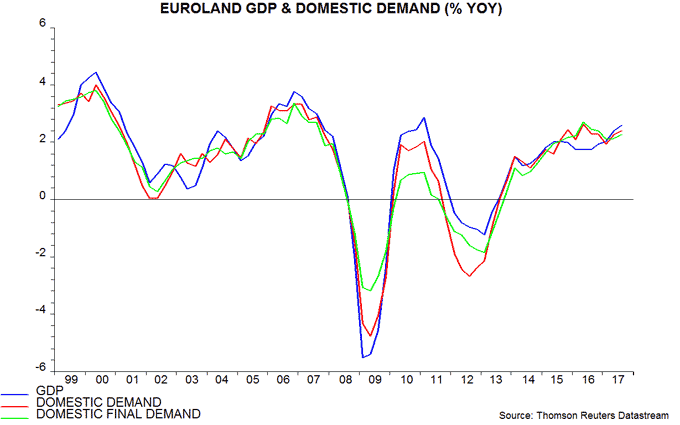
Sustained solid growth of domestic final demand since 2014 – before the ECB embarked on QE – contrasts with an anaemic recovery in 2010-11 after the 2008-09 recession. ECB policy tightening in 2011 was clearly premature and resulted in another recession. This mistake was corrected in 2012-13 under incoming ECB President Draghi – narrow money growth surged, signalling the economic pick-up from 2014.
The subsequent move to negative rates combined with large-scale QE was not warranted by monetary trends and may have overinflated asset prices while laying the foundation for a medium-term inflation overshoot.
The annual increase in the GDP deflator, a broad measure of domestic prices, rose to 1.3% in the third quarter from 0.6% a year earlier – second chart. A similar pick-up in 2014-15 was aborted by pass-through of lower energy costs against the backdrop of a weak labour market. Input cost pressures are currently the strongest since 2011, according to the November purchasing managers’ survey, while labour market slack has fallen significantly since 2015 – third chart.
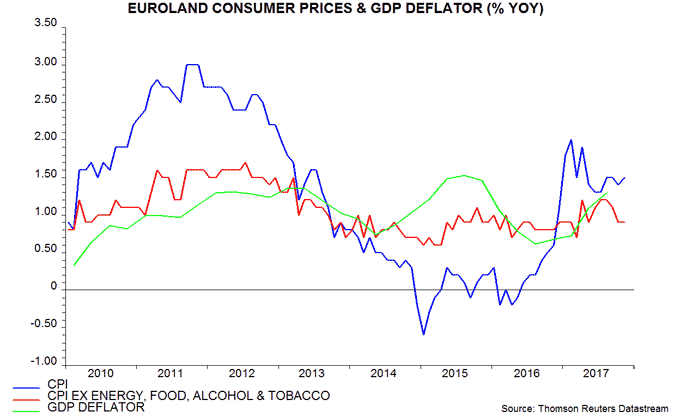
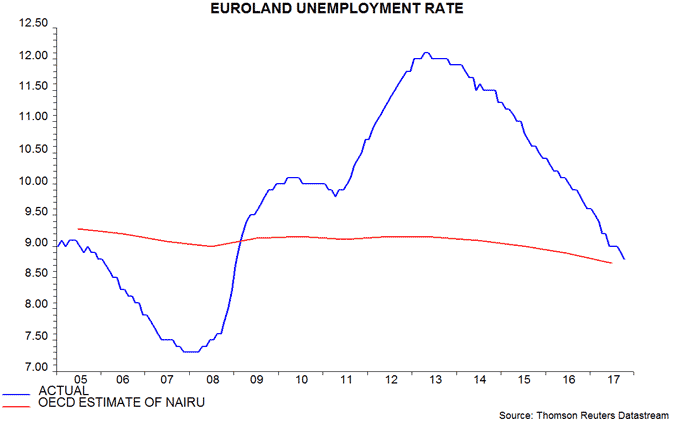
Annual nominal GDP growth moved up to 3.9% in the third quarter, the equal highest since 2008. Stable, strong narrow money growth suggests that nominal GDP will continue to expand robustly – fourth chart. Current growth, if sustained, would imply a rise in inflation to 2.5% or more over the medium term, assuming potential economic expansion of 1.0-1.4% per annum.
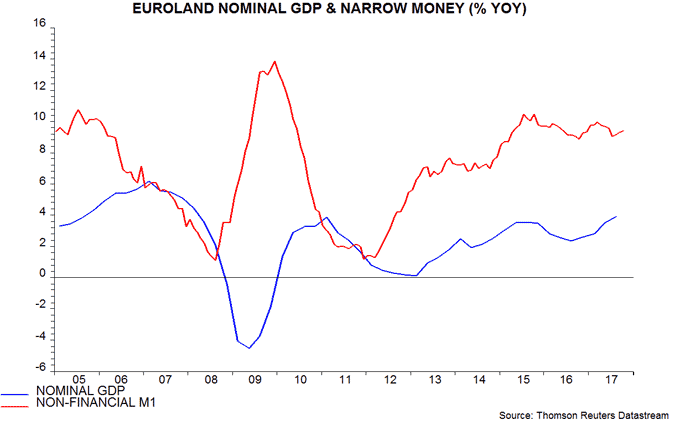
The rise in nominal GDP growth has opened up a record 3.2 percentage point gap with a debt-weighted average of Euroland 7-10 government bond yields, which have detached from economic reality because of negative rates and QE – fifth chart.
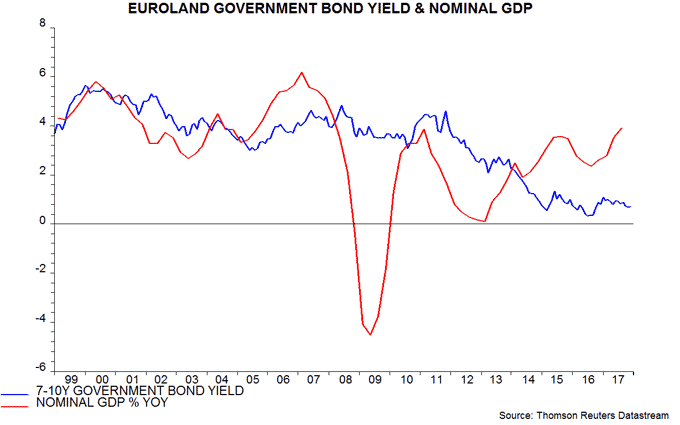
A post in January suggested that the euro, yen and renminbi would rise against the US dollar in 2017, reflecting a narrowing of balance of payments basic balance deficits. The basic balance is the sum of the current account balance and net direct and portfolio investment flows. The Euroland and Chinese basic balance deficits have indeed fallen, while Japan’s balance has moved into surplus.
According to monetary theory, the basic balance position is determined by the difference between domestic credit expansion (i.e. the growth of bank lending to the domestic public and private sectors) and growth in domestic residents’ demand to hold bank liabilities (i.e. broad money plus non-monetary liabilities such as bank bonds). Faster expansion of domestic credit than demand to hold bank liabilities creates “excess” liquidity that is, in effect, exported by running a basic balance deficit.
The earlier post suggested that Euroland domestic credit would slow in 2017 because of ECB QE tapering, while demand for bank liabilities would be boosted by faster nominal GDP expansion. These suggestions have played out – sixth chart. The narrower credit / liabilities growth gap “explains” the decline in the basic balance deficit – seventh chart.
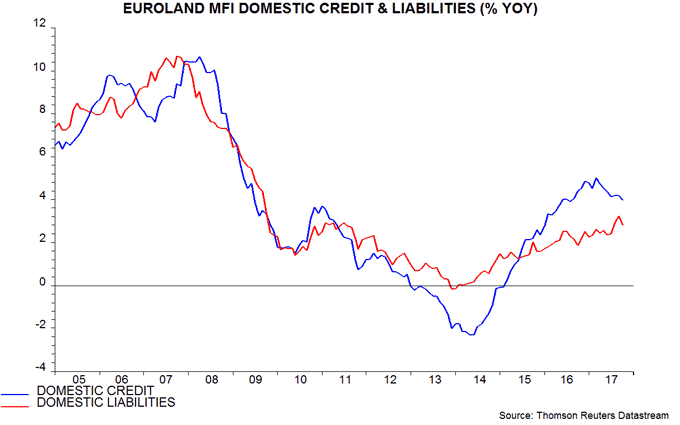
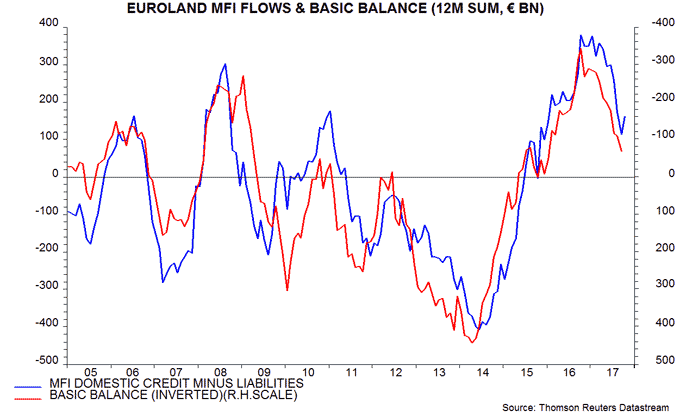
Lower QE from January may result in a further reduction in credit expansion to governments but private lending growth may pick up in lagged response to current economic strength – ECB research found a 1-2 quarter average historical lag between GDP growth and real private loan expansion. The demand to hold broad money and bank bonds, meanwhile, may be depressed by the ECB’s commitment to maintain current negative rates at least through September 2018, despite rising inflation. The fall in the domestic credit / liabilities growth gap, therefore, may stall.
Relative credit / money demand trends may favour the US dollar rather than the euro in 2018. The planned reduction in the Fed’s balance sheet in 2018 is comparable in scale with the slowdown in ECB QE between 2017 and 2018, suggesting a similar drag on domestic credit expansion. US residents’ demand to hold broad money and other bank liabilities, however, may be boosted by rising nominal / real interest rates and repatriation of corporate foreign earnings due to tax reform.

Reader Comments